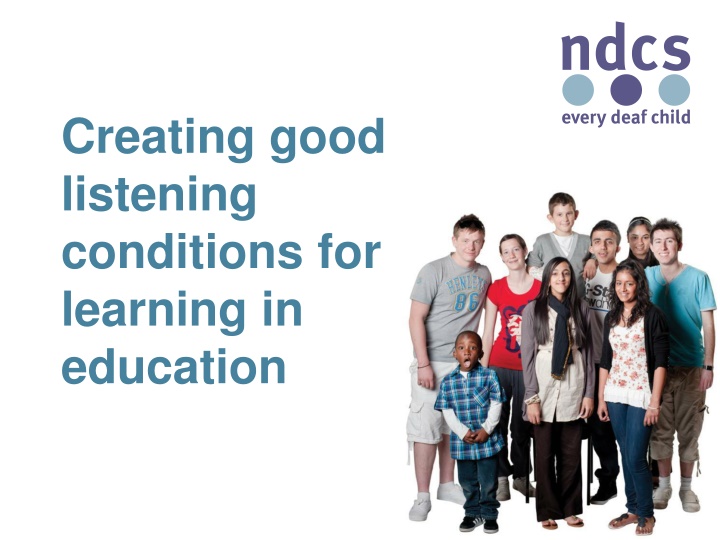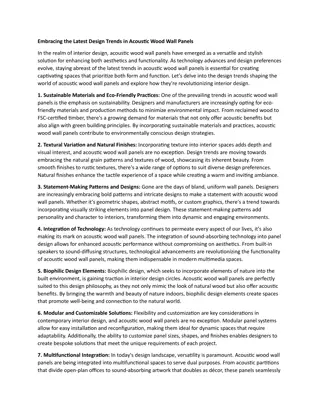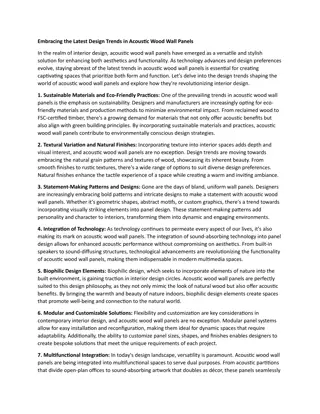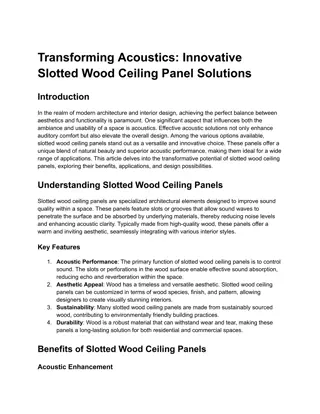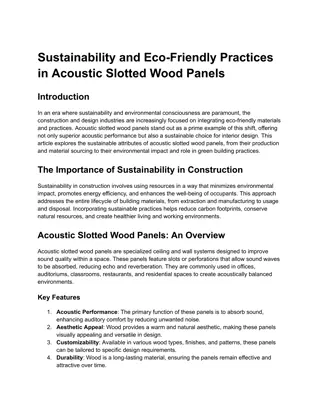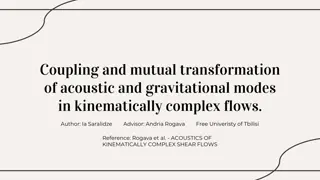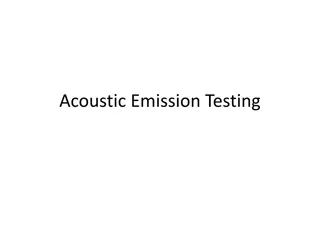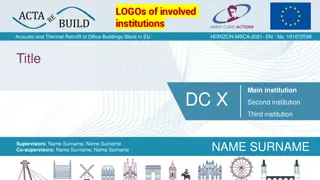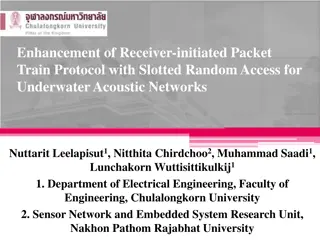Enhancing Learning Environments Through Acoustic Conditions in Education
Explore the impact of good listening conditions on learning in education, including the effects of noise reduction and improved acoustics. Discover how addressing classroom acoustics can lead to a calmer, more focused learning environment for all students, including those with hearing impairments. Consider the importance of creating optimal acoustic conditions to promote better educational outcomes and reduce stress in schools.
Download Presentation

Please find below an Image/Link to download the presentation.
The content on the website is provided AS IS for your information and personal use only. It may not be sold, licensed, or shared on other websites without obtaining consent from the author.If you encounter any issues during the download, it is possible that the publisher has removed the file from their server.
You are allowed to download the files provided on this website for personal or commercial use, subject to the condition that they are used lawfully. All files are the property of their respective owners.
The content on the website is provided AS IS for your information and personal use only. It may not be sold, licensed, or shared on other websites without obtaining consent from the author.
E N D
Presentation Transcript
Creating good listening conditions for learning in education
Todays objectives Look at how listening conditions affect the learning environment for all children, hearing as well as deaf Look at how you can improve the learning environment Think about the legal framework
It seems the louder I speak, the more noise my students make so I speak louder and the students get noisier and I speak louder ... Is there just something wrong with my teaching, or might it be the classroom acoustics?
Impact of reduction in noise and reverberation time After acoustic treatment in their classrooms, teachers and communication support workers reported: Overwhelming improvement in working conditions Quieter and calmer
Impact of reduction in noise and reverberation time Less stress Improvement in behaviour of all children including deaf children Profound effect on the educational experience
Sound simulation Hear for yourself how dealing with your classroom s acoustics can help a child with a high frequency hearing loss www.ndcs.org.uk/simulation
Acoustic requirements To have good listening and speaking conditions a classroom must have: low background noise shorter reverberation time (reduction in echo) good sound insulation between classrooms and to the outside.
Acoustics research Research has shown that improving acoustics helps improve the results of all children. A wide range of attainments and performance factors have been examined to establish the effects of environmental noise.
Impact of poor acoustics Literacy Mathematics Attention Memory They found that all these areas of learning were negatively affected by background noise
The problem with noise Tasks that involve language, such as reading and word problems in mathematics, and those that have high cognitive processing demands involving attention, problem solving and memory appear to be particularly vulnerable to exposure to noise
Listening activity Have a pen and some scrap paper ready Listening in quiet Listening in simulated classroom noise Listening in noise with no access to lipreading
Listening activity The clown had a funny face The car engine s running She cut with her knife Children like strawberries The house had nine rooms The glass bowl broke The dog played with a stick The kettle s quite hot The farmer keeps a bull
The problem with noise Carol Flexer (Hearing Journal August 2002): People can fill in the blanks of missed information only if they have that information already stored in their brain s data bank from where they can retrieve it. Because they do not have those data banks , children need a sharper auditory signal than adults do. So, while a classroom might sound fine to an adult, it may be woefully inadequate for typical children who are neurologically undeveloped and have not had decades of language and life experience.
The problem with noise This means that children require a quieter environment and a louder signal than adults do in order to learn. The younger the child the quieter it has to be.
Effect of classroom noise Background noise level v English score 100 KS2 English score % 80 60 40 20 40 45 50 55 60 65 dB LA90
Effect of external noise Maximum noise level v Maths scores 100 KS2 Maths score % 80 60 40 20 20 40 60 80 100 dB LAmax
Look at the following picture List how many sources of noise there are in the picture Think of your classroom or school Repeat the list for your classroom
Effects of noise on children with SEN Change in spelling scores Change in reading scores 12 40 35 10 30 8 25 SEN Typical SEN Typical 6 20 15 4 10 2 5 0 0 quiet noise quiet noise
Case study A young girl, whose hearing levels are shown by the audiogram opposite, started attending her local nursery. She had been a good hearing aid wearer since she was fitted at the age of 8 months. She is now taking out her hearing aids when she is in the classroom.
Case study plan of room This is a single storey building built away from any roads. Entrance To other classroom Lino The only external noise source on the day of the test was from the class next door 6.35m Carpet cupboard X To the outside Noise from other room T To other classroom Area where children sit when listening to the teacher Critical Distance of the room = 2.05m
Case study It was noticed that: when the pupils were working the teacher always had to raise her voice the teacher was unaware of the noise levels coming from the other classroom and the problems it was causing the teacher had been observed by the head teacher, who mentioned that she had had great difficulty understanding what was being said.
Case study So imagine being a deaf child in that class... The Teacher of the Deaf advised on improving the acoustics to reduce background noise, and the girl s hearing aid use improved.
Signal to noise ratio The signal to noise ratio is a measure of how loud a sound is in relation to background noise This is usually the teacher s voice against background noise, but it could be information from the interactive white board or from other children in the group
Signal to noise ratio British Association of Teachers of the Deaf: For hearing impaired students of all ages the teacher s voice needs to be at least 20dB louder than the background noise to function well in a classroom.
Reverberation (echo) times Reverberation occurs when the sound from the source has stopped, but echoes from the sound continue in the room. If the surfaces have a low absorbency then the sound may bounce around the room, arriving at the child s ear at different times and making it difficult to listen to the message.
Understanding room acoustics Distance Noise Reverberation (echo) ?
Case study Two nurseries decided to have an acoustic survey. One had taken account of good acoustics in developing the learning environment. The other was having problems with noise.
Comparing acoustic conditions Comparing the Reverberation Times for Two Nurseries 0.9 0.8 Reverberation Tim es (s) 0.7 0.6 0.5 0.4 0.3 0.2 0.1 0 125 Hz 250 Hz 500 Hz 1 kHz 2 kHz 4 kHz 8 kHz Frequency BB93 regulation for a mainstream nursery BB93 regulation for a room specifically designed for use with a hearing impaired student
Acoustic factors affecting Acoustic factors affecting understanding of speech understanding of speech Speech intelligibility Reverberation time Signal to noise ratio Background noise level
Video summary www.ndcs.org.uk/professional_support/our_res ources/here_to_learn/reduce_bckgrnd_noi_2.ht ml National Deaf Children s Society, Here to Learn
Apps to help Silent Light app itunes.apple.com/gb/app/silent-light- classroom-timer/id657863900?mt=8 Too noisy app itunes.apple.com/gb/app/id521646496?mt =8&affId=1720307
Amplification in the classroom Soundfield systems help to provide all children in the classroom with an equal sound signal wherever they are sitting. These systems are useful, but they need to be regularly checked and maintained, and do not solve all acoustical problems. They must be installed correctly and the teachers trained in their use.
Soundfield systems a base station receiver classroom help?
Can deaf children benefit from a radio aid?
Can deaf children benefit from a radio aid? A radio aid, set for a particular child s hearing loss, will help to reduce the effects of background noise and improve the signal to noise ratio. It needs to be used in a good acoustic learning environment for the child to benefit from its use. Video: www.youtube.com/watch?v=McOiYgBGf0s
Can deaf children benefit from a radio aid? The teacher s voices are very clear most of the time, even when my friends are talking in class. Lipreading is much easier as there is no delay between the lip movements and hearing the teacher s voice. (deaf pupil, aged 13) Classrooms are loud and busy places. Using a radio aid helped my daughter feel involved .
Can deaf children benefit from a radio aid? The radio aid has made a huge difference to him. Everything has changed his attitude and behaviour. He was struggling with school, he was below average and now he s above average. She can hear people better through the sound of screaming children (at Brownies). She s able to communicate more directly when surrounded by other people.
Statutory The Education (School Premises) Regulations 2012 www.legislation.gov.uk/uksi/2012/1943/ made
Guidance Acoustic design of schools: performance standards (Building Bulletin 93) www.gov.uk/government/uploads/syste m/uploads/attachment_data/file/39245 3/BB93_December_2014_v15.pdf
Equality Act 2010 www.gov.uk/government/publications/equa lity-act-2010-advice-for-schools
What can we do? Carry out a preliminary investigation by interviewing pupils and teachers using documents on the National Deaf Children s Society website at www.ndcs.org.uk/acoustics. Look at practical suggestions to help, as suggested in The National Deaf Children s Society s resource for teachers at www.ndcs.org.uk/acoustics.
What can we do? Discuss your concerns with a Teacher of the Deaf and your school leaders. Consider an acoustic survey of the school by a qualified acoustician.
Video Why Architects Need to Use Their Ears www.ted.com/talks/julian_treasure_why_archite cts_need_to_use_their_ears
